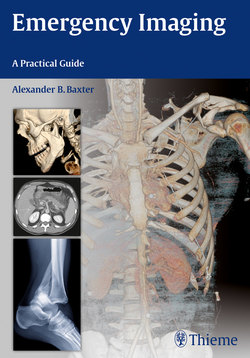Читать книгу Emergency Imaging - Alexander B. Baxter - Страница 96
На сайте Литреса книга снята с продажи.
Оглавление83
3
He
ad and Nec
k
◆Approach
Head and neck conditions evaluated in the emergency department include facial trauma, blunt neck injury, orbital and peri-orbital inflammatory disease, neck masses, pharyngitis, and dental or neck abscesses. Most imaging involves face or neck CT, usually without contrast in the setting of trauma or with contrast for suspected in-flammatory or neoplastic disease.
Facial trauma is common, and in this set-ting the radiologist’s goals are to describe fractures and their displacements, iden-tify specific fracture patterns, anticipate injuries to adjacent soft tissue structures, and communicate findings eectively to the surgeon. In the face, the most impor-tant fracture patterns include nasal and naso-orbito-ethmoid (NOE), zygomatico-maxillary (ZMC) complex fractures, Le Fort fractures, orbital wall fractures, and man-dibular fractures.
Noncontrast CT is the primary imaging study for facial trauma, and multiplanar reformations are essential for accurate in-terpretation. Three-dimensional recon-structions aid in surgical visualization and should be included if available. All facial fractures should be individually listed in the report and assigned to whichever frac-ture pattern they most closely correspond. It is unusual for an acute fracture to involve a sinus wall without intrasinus hemor-rhage. Intraorbital air indicates an orbital wall fracture and potential for complicat-ing orbital infection. If the pterygoid plates are intact, all of the Le Fort fractures are excluded.
Facial Trauma Checklist
First Look
• Blood in sinuses?
• Blood in mastoid air cells?
• Pterygoid fracture?
• Orbital emphysema?
• Orbital hematoma or fat stranding?
Bone Survey
• Frontal sinus
• Nasal bones
• Ethmoid air cells
• Medial orbital walls (with attention to the nasolacrimal duct and attachment of the medial canthal ligament)
• Orbital rim
• Zygomatic arch
• Zygomaticofrontal suture
• Lateral orbital wall
• Orbital floor
• Orbital roof
• Pterygoid plates (involvement of the pterygoid plates defines the Le Fort fractures)
• Maxillary alveolus
• Maxillary sinus walls
• Mandible and temporomandibular joints
• Teeth
• Sphenoid sinus
• Carotid canals
• Mastoid air cells
• Petrous temporal bone (cochleae, vestibule and semicircular canals, ossicles)
